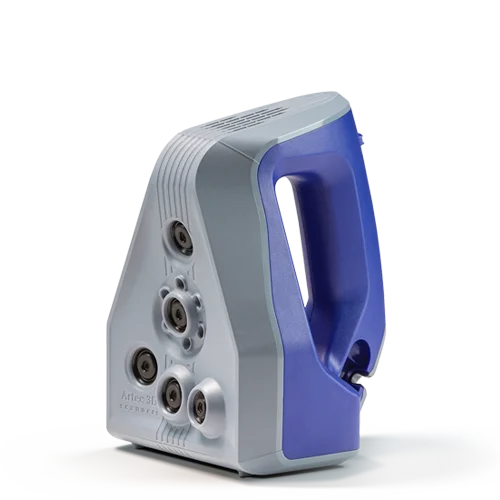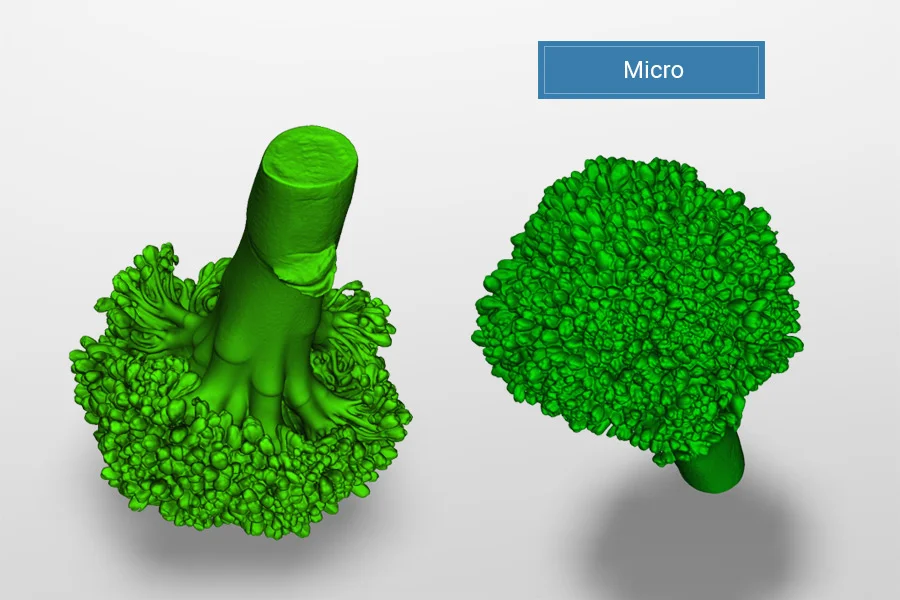Originally published on: December 18, 2018.

Overview
In our testing lab, we’re interested in pushing the boundaries of each 3D scanner we can get our hands on. Our goal is to discover best practices and technologies that result in the highest possible scan quality.
For this demonstration, we scanned an organic object with a complex surface topology, a broccoli, in order to show how each of the 3D scanners in Artec’s lineup handle 3D scanning small objects. We left out two of the 3D scanners designed for scanning larger objects (Artec Ray and Leo) and focused on testing Artec Eva, Space Spider, and Micro. In the end, we compared the results to find the best 3D scanner for scanning small objects.
Here are some reasons why we chose broccoli for this test:

- Broccoli has a range of organic shapes and difficult-to-reach areas that are challenging to scan. The florets grow on tree-like branches that stem from larger branches. This results in a fractal pattern with many cavities, which pushes 3D scanners to their limits.
- This is a test to see how a 3D scanner performs when 3D scanning small objects, with particular attention to the level of detail each device can pick up.
- If the scan shows the individual florets on the broccoli heads, this means we are pushing the system’s limits to the max.
The 3D scanners that stepped up to the plate in this broccoli challenge include the following devices. For the test, all the 3D scanners process the scans using Artec Studio 15. It’s currently the latest version of Artec 3D scanning software.
| 3D Scanner | Type | Handheld/Desktop? | Technical Specifications | |
|---|---|---|---|---|

|
Artec Eva
|
All purpose 3D scanner | Handheld (Point and shoot) |
Resolution: 0.2 mm Accuracy: 0.1 mm |

|
Artec Space Spider |
High-resolution 3D scanner | Handheld (Point and shoot using blue-light technology) |
Resolution: 0.1 mm Accuracy: 0.05 mm |

|
Artec Micro |
Ultra-high-precision metrology-grade 3D scanner | Desktop (Stationary) |
Resolution: 0.029 mm Accuracy: 0.01 mm |
-
Artec Eva (SD vs. HD Mode)

SD Mode vs. HD Mode using Artec Eva 3D Scanner The first contender is the Artec Eva, which is one of the most popular handheld 3D scanners on the market. Its versatility, price point, and scanning results are what makes it an attractive option for anyone looking for a well-rounded, professional 3D scanner.
In the latest version of its scanning software, Artec introduced a new High-Definition Mode (HD) so we wanted to compare the difference between the new HD Mode and the Standard Mode (SD). The new HD mode provides higher resolution scans with dramatic noise reduction—simply by updating to the latest software release (no hardware changes required!)


As you can see from the scan results, using the HD mode provides more detail and sharper definition to the broccoli scan overall.
Although the Artec Eva captures the shape and size of the broccoli perfectly well, the floret details start to get lost as they become clumps, even in the HD mode.The Eva excels at scanning medium-sized objects (such as a motorcycle exhaust system, measurements of the human body, or furniture), but it is not the best option for scanning an object with complex surface topology.
If we’re looking to get more details on the florets, we would need to use a different 3D scanner.
-
Artec Space Spider

Next up is the Artec Space Spider. This device provides the highest-resolution scans out of all of Artec’s handheld 3D scanners.
After we scanned the broccoli using the Space Spider, you can notice a drastic improvement to the 3D scans compared to the Artec Eva. The individual florets are now distinguishable as finer dots. After scanning the broccoli in its entirety, we also picked off a small stem and scanned it to see if we could capture even more detail.


As you can see from the results, the Space Spider has the ability to render complex geometry, sharp edges, and thin ribs. The 3D scanner uses blue-light technology, which sets this system apart. It’s an ideal solution if you are looking for a portable, metrology-grade 3D scanner. The Artec Space Spider is perfect for capturing small objects with intricate details (such as coins, small bones, or mechanical parts).
While the Artec Space Spider is an excellent option, it’s possible to scan fine details at an even higher quality. Let’s take a look at what the Artec Micro has to offer.
-
Artec Micro

The best performing 3D scanner for scanning the broccoli is the Artec Micro 3D scanner. That’s no surprise as this desktop 3D scanner was designed specifically to scan small, detailed objects. We scanned an even smaller piece of broccoli than the Space Spider to show how much more detail the Micro can capture at such a small size. We magnified the Micro scans for a direct comparison with the Space Spider scans. When compared to the Space Spider scans, the Artec Micro scans show the individual florets, clearly visible and with more definition.



Got Questions on Scanning Small Objects?
Ask our SpecialistTakeaways
-
Artec Micro is best at scanning small objects

Here’s a closeup of the broccoli scans using the Artec Micro. You can see the fine details of each individual floret in full clarity. The scan even captures the wrinkles on the stem. Results from the test clearly demonstrate that if you want to capture the best scans for small objects, your best option is a macro 3D scanner like the Artec Micro. This type of 3D scanner is designed and engineered to capture the fine details of extremely small objects with high resolution and accuracy.
It’s important to get the right hardware equipment for the size of the object you are scanning to ensure that you get the best scan results.
-
Choosing Stationary vs. Handheld When 3D Scanning Small Objects
As the results reveal, both the Artec Space Spider and the Artec Micro will do a good job 3D scanning small objects. Depending on how small your object is, sometimes it’s easier to scan a small part using a desktop 3D scanner (like the Artec Micro) versus scanning by hand with a handheld 3D scanner (like the Artec Space Spider). It really depends on the size of your object and the resolution you are looking for. For a lot of applications, the Space Spider does the job. But if you are looking to scan extra small parts or if you want to capture every single detail off a small part, go with the Artec Micro.
Paul explains the differences between using an Artec Space Spider handheld 3D scanner compared to the Artec Micro desktop 3D scanner. Another reason why you would choose the Artec Micro is because it’s also a fully automated desktop 3D scanner which makes 3D scanning an easy process. Its dual-axis rotation system (swing & rotation) creates full 3D models of your object. With the Smart scanning mode, Micro captures every surface of your object with minimal time and effort, using an ideal number of frames. You will save time and megabytes on processing every scan. Everything will be digitized much faster, and you will save on your hard disk space.
You can digitize your objects completely automatically and in minimal time using the Artec Micro desktop 3D scanner. Just mount the object on the scanning platform and go. Micro takes care of the rest. -
For the Artec Eva, HD mode provides better resolution than SD mode with a simple software upgrade.
You can see that even with a simple Artec Studio 3D scanning software upgrade to version 15 using the HD mode, there is a visible difference in terms of the detail you can capture using the same hardware. Just updating the firmware of your 3D scanner can help you get improvements to your scan quality.
Carla Lauter, Editor of Geo Week News, sums up the HD Mode upgrade the best:
“Imagine downloading an update to your computer that enabled its processor to go twice as fast, or downloading an update to your TV that produced a picture twice as sharp.”

-
Choose a 3D scanner with the field of view that best fits your application.
To get the optimal results out of a 3D scanner, you need to choose a system that is appropriate for the size of the object you are looking to scan. For example, if you are using a knife to cut bread, you would get better results if you use a bread knife than using a butter knife. The same applies for 3D scanners. Once you use the right tool for the job, you will be able to get the results you are looking for.
This reference guide gives indicates which Artec 3D scanner is best at scanning for a particular size of objects.
| 3D Scanner | Type | Choose Scanner By Your Object Size |
|---|---|---|

|
Artec Eva |
Medium-sized Objects (M): Gearboxes, construction equipment, castings, alloy wheels, human body, furniture, statues |

|
Artec Space Spider |
Small-sized Objects (S): Compressors, small tools, PCBs, keys & coins, fasteners, small archaeological objects, body parts such as ears and jaw bones |

|
Artec Micro |
Extra-Small Sized Objects (XS): Engine valves, connectors, small parts, watch gears & parts, electronic components, human teeth & jewelry |

Webinar: 3D Scanning Small Objects with Amazing Results
Check out common questions about 3D scanning small objects and how to solve them.
View Webinar